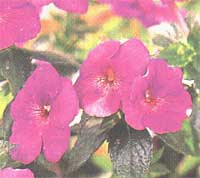Achimenes / achimenes
Refers to the family gesnerievyh. Fatherland is Central America.
General description: It differs in that it flourishes abundantly with large funnel-shaped flowers with a fine bend of the corolla. Coloring in different varieties is different, but always very bright: pink, purple, yellow, blue, snow-white, purple, etc. Flowering period from June to October. The leaves are velvety, pubescent, heart-shaped with a serrate margin. The stems are weak and thin, achymenes ideally placed in hanging baskets. You can tie the shoots to the supports to give a bushy species.
Ahimenez is a tuber plant, it is cut off for the winter. Purified and dried tubers are stored in a dark cool room.
The most common species is Achimenes hibridia (Achimenez hybrid). He has many varieties with flowers of different colors.
Recommendations for caring for the plant Ahimenez:
Illumination : Photophilous, in the warm season, scattered light is preferred.

Achimenez - Achimenes
Irrigation regime : Abundant during the growth period, after flowering, the watering gradually decreases, in the rest period, if the plant is not taken out of the ground in any way, it is not watered at all.
Humidity : Likes high humidity, but does not like spraying. It is better to spray the atmosphere around the plant and arrange containers with water. He likes fresh air, but without drafts.
For the summer it is better to place on a fresh atmosphere (in a park or on a balcony) in a shaded room, but on a cool night must be brought into the building.
Temperature regime : Moderate, during the growth period no lower than 15 - 17 ° C. Poorly tolerates sharp temperature changes.
Soil : Very good bore is needed. You can add charcoal and brick chips.
Recommended soil mixture: 3 elements of leaf land, 1 share of peat and 1 share of sand. Add dry cow dung, sphagnum moss.
During the growth period, it needs fertilizing once every two weeks with fertilizer for flowering plants.
Breeding : Preferably nodules, allowed by cuttings and seeds.
Transplantation : During the period of inactivity, the rhizomes are usually removed from the ground and stored until the spring planting in dry peat at a temperature of at least 7 ° C. Sprouted in light nutrient soil at a temperature of 15-18 ° C and high atmospheric humidity.
The root system is superficial, so the pot must not be deep.
Pests : Most often it is affected by mealybugs (covered with snow-white cotton wool) and aphids.
The plant is allowed to help finish with a soap solution, warm washing and spraying with an actinic (1-2 ml per liter of water).


Comments
When commenting on, remember that the content and tone of your message can hurt the feelings of real people, show respect and tolerance to your interlocutors even if you do not share their opinion, your behavior in the conditions of freedom of expression and anonymity provided by the Internet, changes Not only virtual, but also the real world. All comments are hidden from the index, spam is controlled.